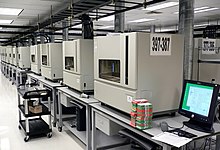DNA sequencer

DNA sequencers
|
|
| Manufacturers | Roche, Illumina, Life Technologies, Beckman Coulter, Pacific Biosciences |
|---|---|
A DNA sequencer is a scientific instrument used to automate the DNA sequencing process. Given a sample of DNA, a DNA sequencer is used to determine the order of the four bases: G (guanine), C (cytosine), A (adenine) and T (thymine). This is then reported as a text string, called a read. Some DNA sequencers can be also considered optical instruments as they analyze light signals originating from fluorochromes attached to nucleotides.
The first automated DNA sequencer, invented by Lloyd M. Smith, was introduced by Applied Biosystems in 1987. It used the Sanger sequencing method, a technology which formed the basis of the “first generation” of DNA sequencers and enabled the completion of the human genome project in 2001. This first generation of DNA sequencers are essentially automated electrophoresis systems that detect the migration of labelled DNA fragments. Therefore, these sequencers can also be used in the genotyping of genetic markers where only the length of a DNA fragment(s) needs to be determined (e.g. microsatellites, AFLPs).
The Human Genome Project catalysed the development of cheaper, high throughput and more accurate platforms known as Next Generation Sequencers (NGS) to sequence the human genome. These include the 454, SOLiD and Illumina DNA sequencing platforms. Next generation sequencing machines have increased the rate of DNA sequence substantially compared with previous Sanger methods. DNA samples can be prepared automatically in as little as 90 mins, while a human genome can be sequenced at 15 times coverage in a matter of days.
...
Wikipedia
